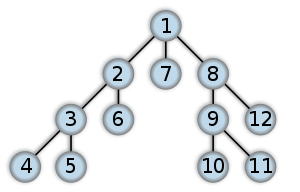DFS(深度优先搜索)
深度优先搜索算法(英语:Depth-First-Search,DFS)是一种用于遍历或搜索树或图的算法。
沿着树的深度遍历树的节点,尽可能深的搜索树的分支,当节点v的所在边都己被探寻过,搜索将回溯到发现节点v的那条边的起始节点。这一过程一直进行到已发现从源节点可达的所有节点为止。如果还存在未被发现的节点,则选择其中一个作为源节点并重复以上过程,整个进程反复进行直到所有节点都被访问为止。属于盲目搜索。 ---《维基百科》
 |
|
树的DFS:
算法实现
- 首先将根节点压入栈中;
- 从栈中取出第一个节点,并检验它是否为目标;
- 如果找到目标,则结束搜寻并回传结果,否则将它的右子结点和左子结点先后压入栈中;
- 重复步骤2,直到栈为空。
/* * 树的深度优先搜索 * 省去了初始化树的部分 */ // 树的结点类型 struct Node { int self; // 结点值 Node *left; // 左结点 Node *right; // 右结点 }; int target = 5; // 要查找的值 const int TREE_SIZE = 9; // 树的结点个数 std::stack<Node *> unvisited; // 未访问过的树结点指针 Node nodes[TREE_SIZE]; // 树的结点数组 Node *current; // 当前指向的结点指针 void dfs(){ unvisited.push(&nodes[0]); // 根节点入栈 while (!unvisited.empty()) { current = unvisited.top(); unvisited.pop(); if(current->self==target){ // do something return ; } if (current->right != NULL) unvisited.push(current->right); // 右结点入栈 if (current->left != NULL) unvisited.push(current->left); // 左结点入栈 } }
图的DFS:
算法实现
- 创建一个访问数组,每次访问一个结点时将该结点在访问数组中的值置1;
- 检验当前结点的值与目标值是否相等,相等则返回,否则,生成下一个结点的坐标;
- 检验下一个结点的坐标是否符合条件,若符合条件则递归的遍历下一个结点;
- 重复步骤2、3,直到所有结点遍历完毕。
/* * 图的深度优先遍历 * 图采用邻接矩阵存储 * locateVex() - 计算顶点的下标 * createGraph() - 创建图 * dfs() - 深度优先遍历图 */ #include <iostream> #include <stack> using namespace std; const int MAXN = 100; stack<char> q; bool visited[MAXN]; typedef struct Graph { char vexs[MAXN]; //顶点表 int arcs[MAXN][MAXN]; //邻接矩阵 int vexnum, arcnum; //当前的顶点数和边数 } Graph; int locateVex(Graph &graph, char v) { for (int i = 0; i < graph.vexnum; i++) if (graph.vexs[i] == v) return i; return 0; } int createGraph(Graph &graph) { int i, j, k; char v1, v2; cout << "please input the number of vertices and the number of edges:" << endl; cin >> graph.vexnum >> graph.arcnum; // 读入顶点信息 cout << "please input vertex information:" << endl; for (i = 0; i < graph.vexnum; i++) cin >> graph.vexs[i]; // 初始化邻接矩阵边,0表示顶点i和j之间无边 for (i = 0; i < graph.vexnum; i++) for (j = 0; j < graph.vexnum; j++) graph.arcs[i][j] = 0; // 读入边集信息 cout << "please input the edge information:" << endl; for (k = 0; k < graph.arcnum; k++) { cin >> v1 >> v2; i = locateVex(graph, v1); //找到顶点i的下标 j = locateVex(graph, v2); //找到顶点j的下标 graph.arcs[i][j] = graph.arcs[j][i] = 1; } return 1; } void dfs(Graph &graph, char v0) { int cur, cur_index; int index0 = locateVex(graph, v0); visited[index0] = 1; q.push(v0); cout << "the result is:" << endl; while (!q.empty()) { cur = q.top(); // q.pop(); // 将栈顶头元素出栈 cur_index = locateVex(graph, cur); //得到顶点对应下标 cout << graph.vexs[cur_index] << " "; for (int i = 0; i < graph.vexnum; i++) { if (graph.arcs[cur_index][i] && !visited[i]) { q.push(graph.vexs[i]); //将顶点入队 visited[i] = 1; //顶点已被访问 } } } } int main() { Graph graph; createGraph(graph); dfs(graph, 'a'); return 0; }
本博客所有文章除特别声明外,均采用 CC BY-NC-SA 4.0 许可协议。转载请注明出处!




 浙公网安备 33010602011771号
浙公网安备 33010602011771号